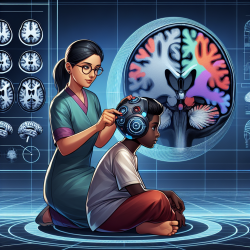Introduction
In the ever-evolving landscape of healthcare, the early detection of Alzheimer’s disease and related dementias (ADRD) is a crucial challenge. The recent study "Digital detection of dementia (D3): a study protocol for a pragmatic cluster-randomized trial examining the application of patient-reported outcomes and passive clinical decision support systems" offers a beacon of hope for practitioners seeking to improve their diagnostic acumen. By integrating patient-reported outcomes with passive digital markers, this study presents a dual approach that could revolutionize early ADRD detection.
The Power of a Dual Approach
The study introduces a novel methodology that combines the Quick Dementia Rating Scale (QDRS) with a Passive Digital Marker (PDM) derived from electronic health record (EHR) data. This dual approach aims to enhance the accuracy and timeliness of ADRD diagnosis in primary care settings. By leveraging machine learning algorithms, the PDM can predict ADRD with 80% accuracy for one-year and 77% for three-year horizons. This predictive power, when combined with the QDRS, which boasts an 85% diagnostic accuracy, creates a formidable tool for practitioners.
Practical Implications for Practitioners
For practitioners, the implications of this study are profound. Here are some key takeaways:
- Enhanced Diagnostic Accuracy: The integration of QDRS and PDM can significantly improve the accuracy of ADRD diagnosis, allowing for earlier intervention and better patient outcomes.
- Scalability: This approach is designed to be scalable across diverse primary care settings, making it accessible to a wide range of healthcare providers.
- Cultural Sensitivity: The QDRS is culturally and linguistically sensitive, making it suitable for multi-cultural populations, a critical factor in diverse communities.
- Cost-Effectiveness: By reducing the need for invasive and expensive diagnostic tests, this approach can lower healthcare costs while maintaining high diagnostic standards.
Encouraging Further Research
While the findings of this study are promising, they also open the door for further research. Practitioners are encouraged to explore the following areas:
- Integration with Other Tools: Investigate how this dual approach can be integrated with other diagnostic tools and technologies to further enhance its effectiveness.
- Longitudinal Studies: Conduct long-term studies to assess the impact of early ADRD detection on patient outcomes and healthcare costs.
- Patient and Caregiver Education: Develop educational programs to inform patients and caregivers about the benefits of early ADRD detection and the tools available.
Conclusion
The "Digital detection of dementia (D3)" study offers a groundbreaking approach to early ADRD detection. By harnessing the power of machine learning and patient-reported outcomes, practitioners can improve diagnostic accuracy and patient care. As we continue to navigate the complexities of ADRD, this study serves as a reminder of the importance of innovation and research in healthcare.
To read the original research paper, please follow this link: Digital detection of dementia (D3): a study protocol for a pragmatic cluster-randomized trial examining the application of patient-reported outcomes and passive clinical decision support systems.










